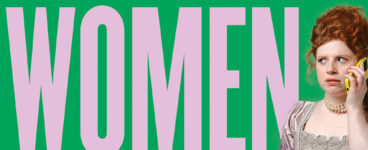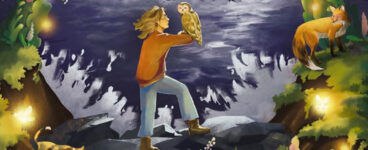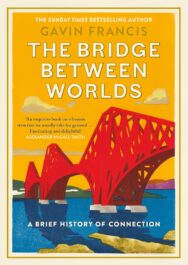‘As a child reading my Ladybird books I marvelled at the power and possibilities of bridges, and even dreamed of living on one. As I get older I realise how much each of us lives by them.’
Gavin Francis dives deep into the history of bridges in his latest book, analysing not only their historic significance, but what they represent as symbols of connection. In this extract, he reflects upon his own memories of crossing the Forth Bridge connecting Lothian and Fife.
The Bridge Between Worlds: A Brief History of Connection
By Gavin Francis
Published by Canongate
In my loft at home there’s a newspaper clipping of a photograph of the Forth Road Bridge, with me and a thousand or so others setting off from its southern approach on a charity run. I was a couple of months shy of my thirteenth birthday; friends and family were to pledge a coin or two for every lap that could be made of it.
Runners stream past a caravan set up by the organisers, some frowning, some shouting, some grinning as they jostle together, each finding their space and their rhythm. By chance the press photographer has framed me dead centre: a Nike T-shirt, a sweatshirt tied around my waist, white sports socks pulled up tight, one of the smallest runners in the crowd. The camera has also caught the haze that day over the Forth estuary – the coast of Fife is almost lost in the mist of distance. As I ran twelve crossings of the bridge my feet felt winged, soaring over the river’s cargo of ships and sailboats.
I was not bad as a long-distance runner, wiry and slight. Running suited me because of its solitude, and because of the way I could feel my heart beating in time with the rhythm of my feet, my lungs heaving in my chest even as my mind grew ever more airy and light.
From the hilltop behind my childhood home it was possible to see the topmost spires of the Forth Road Bridge, its towers painted the grey of doves’ wings, and also of battleships. A Sunday afternoon’s outing might be to take a walk over the bridge and back. If you close your ears to the traffic but open your eyes to the landscape, it’s a walk to expand your mind as well as your vision.
A suspension bridge in the grand San Francisco style, it’s an estuary-wide handfast of concrete and steel. Two immense towers more than a kilometre apart suspend twin garlands of cables that hang in graceful parabolas, like playmates swinging a couple of skipping ropes. Each cable is over half a metre thick, spun from 12,000 high-tensile wires and bearing 14,000 tonnes of weight – you could hang the Statue of Liberty off them, or three Eiffel Towers.
Two a half kilometres long, flanked by walkways and cycleways, with handrails like an ocean liner, it is fortified by gantries of trussed cross-beams to prevent it flexing in high winds. It was opened in 1964 by Queen Elizabeth as the Beatles’ ‘A Hard Day’s Night’ dropped to number 10 in the charts, and the Kinks’ ‘You Really Got Me’ reached number 1. Its designers boasted that it would last 120 years, but the burden of traffic it has been obliged to bear has meant it needed reinforcement long before that. On that day in 1964 the Queen was driven north over the bridge, then sailed back again by ferry – the final passenger of a service that had been running for nine centuries. Three men died in the bridge’s construction; several were saved by safety nets strung beneath decks. If you fell through those nets, it was a drop of 160 feet to the sea.
The bridge was astonishing in its day for the elegance of its slender towers, which had to be built in five sections. Its north tower was built first, 156 metres tall; it swayed even in light winds before a dampening system was laid into it. The anchors for each cable are buried 80 metres deep into the bedrock of both shores. Those hidden anchors confer the strength necessary for the openness and connectedness of the bridge – an apt metaphor for all those unseen footings that our connections rely upon. The spinning of wire for its cables began in 1961 but was delayed by winter gales that year, which folded them in knots so tangled they had to be cut out. The decks of the bridge hang from its principal cables in 20- or 30-metre segments; metalled gaps between each segment allow for heat expansion in the summer. Cars driving over the bridge make a percussive rhythm as their wheels rumble over these metalled gaps, as if the bridge itself has a heartbeat and comes alive through the motion of those who cross it. Like the Golden Gate Bridge in San Francisco, and the Pont Neuf in Paris, the crown of the bridge is a renowned spot for suicides, but also for declarations of love: fixed there are grids of steel wire festooned with padlocks, each marked with hearts and the initials of lovers. It’s a relatively new tradition, one thought to have started in Rome only within the last twenty years or so, underlining the way that the meanings we ascribe to bridges are always evolving.
To cross any strait or watercourse, either by boat or by ford, has always been a risky activity, and was once much more so. Charon, ferryman of the Styx, demanded payment for access to the afterlife and to the bliss of forgetting; without that payment, the souls of the dead were trapped on the wrong side of the divide as ghosts, haunted by memories of their lives’ misdeeds. In some ages and some cultures bridges have been seen as horizontal crossings to another world; in others, the crossing is vertical, with death coming as a fall from the precarious bridge of life. For Nietzsche, ‘what is lovable in man is that he is an OVER-GOING and a DOWNGOING’. As with death, birth too is a risky crossing between worlds, and the umbilical cord a life-giving bridge between mother and baby.
To confront the risks of river crossings, my own country developed a complex mythology of water spirits – ‘kelpies’ – that were to be appeased or avoided by travellers. Kelpie stories flourished until the military bridges of the eighteenth century made such myths unnecessary. Flowing waters have long been considered symbolic of the turbulence of life, and bridges, like ferries, emblematic of passage between its stages. As a child reading my Ladybird books I marvelled at the power and possibilities of bridges, and even dreamed of living on one. As I get older I realise how much each of us lives by them.
Little remains to me now of that day running back and forth over the bridge at the age of twelve: a few flashing images of hot, exhilarating hours as I clocked up first ten, then twenty, then thirty kilometres back and forth between Lothian and Fife, Fife and Lothian. From the crown of the arch of the bridge the view was almost Olympian, and on that run I felt less earthbound than skybound. It seems to me now that I was running from the past into the future, from childhood into adolescence.
The Bridge Between Worlds by Gavin Francis is published by Canongate, priced £20.
ALSO IN THIS ISSUE

 Eleanor Morton’s Five Favourite Scottish Women
Eleanor Morton’s Five Favourite Scottish Women
‘Scottish women often feel overlooked in history, and Williamina’s name should be much better known …

 The Edge of the Silver Sea by Alex Mullarky
The Edge of the Silver Sea by Alex Mullarky
‘She wishes, out loud, for a way home – and she is answered…’













